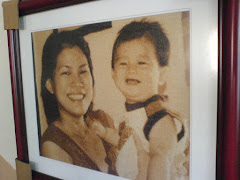The art or craft of cross stitch is one of the most popular hobbies in the world. Easy to learn and do, 'cross stitch' is simply embroidery stitched with lots of little 'X' stitches to create a lovely design. This fun craft is sometimes referred to as 'counted cross-stitch' because the pattern and fabric require the crafter to count the number spaces to know where to place the stitches.
Most often, cross stitch patterns are done using a woven fabric called Aida cloth. Some advanced stitchers create designs on other types of fabrics using a special backing to help keep the stitching uniform. The kind of fabric you use depends on your skill level and the type of design you're creating. I've cross stitched designs on my children's clothing, bedding and other items for my home and as gifts.
Skilled cross stitch crafters create beautiful projects by stitching on plastic and various different papers as well. Gift cards and scrapbook designs may be made by stitching on paper of varying thickness and fiber.
Of course you can't cross stitch without the proper thread. The threads used in counted cross stitch range from basic cotton, to wool or silk threads. Usually very colorful, embroidery floss as it's called, comes in all kinds of colors and textures for you to play with.
If you're just beginning to consider learning to cross stitch, your best bet is to learn about the craft itself before you start buying supplies. Your local craft store, bookstore, or library will most likely have several books available that will teach you and provide easy patterns to start with.
Once you know what's expected of you in the craft of cross stitching, you'll want to find some easy projects to begin with that will allow you to learn as you go. You'll want to start with a project that requires only a few colors of thread and a larger weave Aida cloth. By doing so, you'll prevent a lot of unnecessary learner's frustration.
When you sit down to start your first cross stitch project, you'll want to have all of your materials available and easy to get to. Start out by reading through the project instructions. You'll want to look over your pattern and make sure that you understand all of the jargon and markings that you may find on the pattern. There will be a color key that you'll need to understand so that you use the correct thread color. Make sure to have a pencil handy to make notes or your own marks on the pattern for later reference.
Cross stitching requires you to use a six strand of floss or thread and separate it into individual threads. Your pattern will tell you how many threads you'll use at a time. Most often, the larger the weave of your fabric, the more strands of embroidery floss you'll need at a time. Don't rewind your floss and by all means don't let it get tangled or bunched up. Your end project will look flat and even if you take care of your floss.
One key factor in learning to cross stitch is remembering not to knot your thread. Knotting threads in a cross stitch project will make your end result look lumpy and uneven; not a good thing. Just pull your thread through your Aida cloth and make sure to leave a length of thread on the end in the back. You can keep the bit of tail from going completely through the fabric by holding onto it on the back of your fabric as you make your first couple of stitches; they will overlap and hold the thread in place. You may have to practice this easy technique a few times, but you'll get the hang of it soon enough.
Another handy cross stitching tip is when you're ready to change thread colors, just simply pull your needle through the stitches on the back of your fabric to hold your thread before you snip it off with scissors. Make sure to leave a little bit of thread so that it does not come loose and unstitched. Change your thread color and start on the next area of your project as you did before. And during the stitching process, remember to drop your needle every few stitches, meaning, just hold your project in one hand and let the attached needle and thread dangle from the fabric so that the thread unwinds and your next few stitches will be flat.
source: EzineArticles.com by Sherry Frewerd
Subscribe to:
Post Comments (Atom)







No comments:
Post a Comment